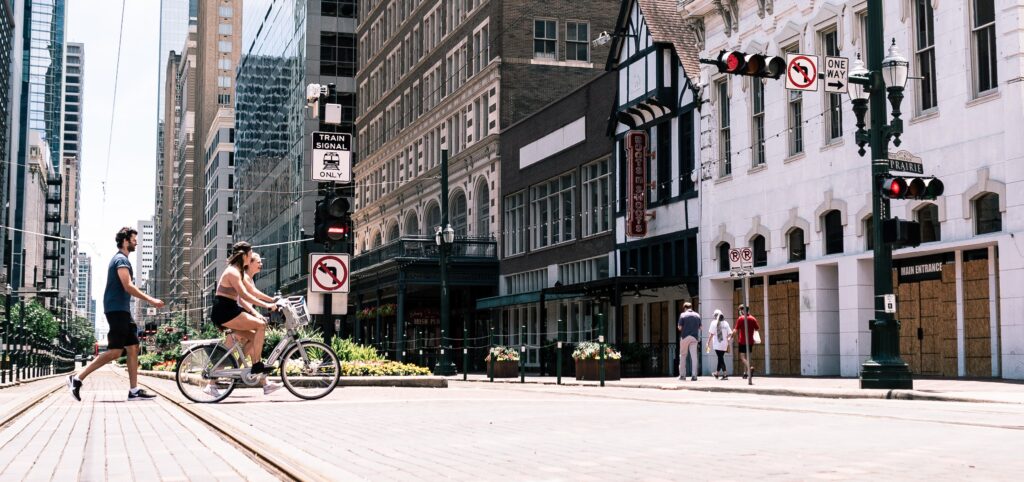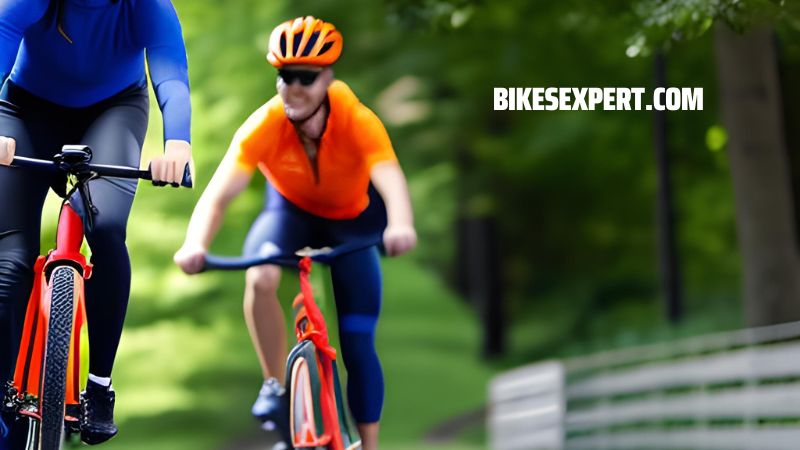Whenever you ride your bicycle out on the street. I want you and your family to stay safe. So I wrote this safety guide for you. So please practice what you learn about bicycle safety.

Bicycling is a great way to get around town, save money, and stay healthy. But like anything else, it can be dangerous if you don’t know how to properly ride a bike. In this blog post, we’ll provide you with 12 safety tips that will help you stay safe while biking on the road.
We’ll discuss things like bike maintenance, avoiding traffic accidents, and staying aware of your surroundings.
By following these tips, you’ll be able to ride your bike with confidence and avoid any serious injuries. So read on and learn everything you need to know about safe biking on the road!
12 Bike Safety Tips:
- Wear correct safety equipment.
- Understand which circumstances are more likely to result in crashes.
- Follow road regulations.
- Be seen, ensure a car driver can spot you
- Wear vivid colors
- Use bike lights.
- Learn the hand signals.
- Avoid using headphones and mobile phones
- Remain sober
- Dont ride recklass
- Maintain your bike in pristine condition
- Ride a bicycle right for your size and height
Why Is Bicycle Safety So Crucial?

According to the CDC, bicyclists are more likely than automobile drivers to be critically wounded or even killed, even though bicycle travel accounts for just 1 percent of all journeys in the United States. Fortunately, bikers may reduce their exposure to danger by practicing bicycle safety.
For example, choosing a bicycle that fits your riding style and body type and locating a helmet that adequately protects you in a collision.
And wearing protective equipment such as a luminous vest or adding rearview mirrors are excellent strategies to increase safety before your next ride.
Cycling is a delightful hobby, but it is not without danger. In 2019, the National Highway Traffic Safety Administration (NHTSA) reported that 846 cyclists were killed in traffic accidents.
In addition, between 2009 and 2018, there were about 600,000 emergency department visits for traumatic brain injuries due to bicycles.
However, understanding and implementing fundamental safety precautions, including wearing a helmet, may significantly lower the risk of bicycle-related injury.
Bicycle Safety Figures
When it comes to bicycle safety, some individuals are more susceptible to injury and death. The following data and statistics describe the prevalence of mortality and injury among the general population.
- The Governors Highway Safety Association reports that 88 percent of bike deaths involve adults.
- According to the CDC, males die six times more often riding bicycles than women.
- The CDC also discovered that the greatest bicycle fatality rates are among those 50 to 59.
- The highest number of bicycle-related fatalities occurred in August, with the lowest number in January.
- The Insurance Institute for Highway Safety reports that 78 percent of bikers murdered in 2019 were killed in metropolitan areas.
- The most hazardous state for bicycles is Delaware.
How Can I Enhance My Bicycle Safety?

When it comes to being safe when riding a bicycle, you, the rider, have most of the responsibility. Here are some strategies to increase your bicycle safety.
1. Wear A Helmet
As a road bike owner, I know how exhilarating it can be to ride fast down the road. However, I also know how quickly things can go wrong if you’re not prepared. One time, I was riding my road bike down a steep hill when a deer suddenly appeared in front of me. I had no time to react, and I ended up slipping off the bike and crashing to the ground. Luckily, I was wearing a helmet that absorbed most of the impact. Without it, my head would have been severely damaged, and I might not have survived.
This experience taught me the importance of always wearing a helmet when riding a bike. Helmets can significantly reduce the risk of head injuries, which are one of the most common types of injuries in bicycle accidents. In fact, the National Highway Traffic Safety Administration concluded that wearing a helmet can lower the likelihood of suffering a major head injury by 60 percent.
Read more about What Protective Gear Do I Need For Mountain Biking?
2. Follow Road Regulations
Cyclists must respect the same traffic laws as automobiles, including traffic signals and posted signs. There may be biker-only signs that you must obey on certain paths, like stop signs. Please be aware that riding on the sidewalk is forbidden in many places.
3. Dress In Vivid Hues
The brighter your attire, the greater the likelihood that drivers will spot you. Some studies have shown that wearing fluorescent clothes on both the top and lower body enhances both the chance of being spotted and the distance one may be seen. If you want to ride at night, you should wear luminous clothes to maximize your visibility.
4. Avoid Using Headphones And Mobile Phones
When riding a bike, you must be able to hear what’s going on around you. Listening to music or conversing on the phone might prevent you from hearing a vehicle approaching from behind or serve as a needless distraction.
5. Learn The Hand Signals
Bicycles do not have brake lights or turn signals; therefore, you must use hand signals to indicate to other cars on the road that you are stopping or turning. Learn these signs and use them in your riding for a safer experience.
Left Turn:
To indicate that you desire to make a left turn, extend your left arm straight to the left.
Right Turn:
To indicate that you want to make a right turn, extend your right arm straight to the right.
Slowing Down:
Extend your left hand and move your hand upwards and downwards
Stop / Halt
With you palm open extend your left arm to the left and bend your elbow down, such that the palm of your hand faces backwards. This signals that you wish to halt.
Rememember to do these manoeuvres well before your turn.
6. Select The Appropriate Bicycle Size For Your Height And Inseam
Riding a bike of the correct size is one of the essential things you can do for bike safety. If your bicycle is too oversized or too little, you will have less control over it, which might make it impossible to avoid an accident.
Most manufacturers will include a sizing guide to assist you in choosing the appropriate bicycle for your height and inseam. However, do not assume that the size of your bike is universal since various models of bicycles have varying sizing.
7. Maintain Your Bike In Pristine Condition
Before every ride, you should do a few basic checks to avoid unintended breakdowns. Recall your ABCs:
- Are your tires adequately inflated?
- Are your brakes in good operating order?
- Are your chain’s links clean and lubricated?
- Are your gears changing smoothly?
8. Follow the Current
Always ride your bicycle in the traffic direction. In the United States, it is against the law to ride in the middle of the road. It is for your own protection. When you’re going against traffic flow, it’s impossible to see road signs and traffic lights. Additionally, you are far more likely to be observed by traffic if you ride in the same direction as it.
9. Remain Sober
You would not drive a vehicle while intoxicated; therefore, it follows that you should not ride a bicycle when intoxicated. Depending on how your state defines “vehicle,” a DUI charge may be levied if you are stopped while riding a bicycle under the influence. You risk a public intoxication prosecution in other states. In addition to the legal consequences, riding under the influence is dangerous. There were 37 percent of bike deaths in which the rider or the driver was under alcohol.
10. Refresh Your Cycling Abilities
Whether you’re starting to ride a bike for the first time or have been riding for years, practicing bike riding is a fantastic method to be safe on the road. Make sure you’re comfortable riding at fast speeds, braking rapidly, changing gears, and crossing diverse heights before you hit the road.
How Do Most Bicycle Collisions Occur?

- A car turns right onto the same path as the rider.
- A driver fails to see the rider on the road.
- A parked car door unexpectedly opens and hits the rider.
- A bike rider slows down without signaling, and a car hits them from behind.
To avoid these collisions, riders should:
- Go farther to the left and slow down in advance when a car turns right.
- Keep a distance of one car door from parked vehicles to avoid collisions with opening doors.
- Always signal when slowing down to prevent rear-end collisions.
- Use hand signals to indicate turns or stops when riding on the road.
Cyclists and automobiles must keep an eye out for one another on the road so that everyone may safely share the road. By understanding which circumstances are more likely to result in crashes, everyone can be more cautious and limit the number of biker-car incidents.
Most bike-vehicle incidents occur when a cyclist travels straight, and a car turns right onto the same path as the rider. Either the automobile will turn into a bicycle, or the rider will sprint right into the car as it turns.
As a rider, you must be conscious of these circumstances. Therefore, whenever feasible, go farther to the left, slow down in advance, and attempt to attract the driver’s attention. If you are uncertain whether the driver has spotted you, wave your arm and be prepared to move rapidly if necessary. As a vehicle driver, a heightened awareness of cyclists, in general, may assist prevent collisions between cars and bicycles.
A common accident involving vehicles and bicycles is when a cyclist is hit by the unexpected opening of a parked car door. As experienced cyclists are likely aware, colliding with a vehicle door at full speed may significantly injure. Cyclists may prevent this danger by always maintaining a distance of one car door from parked vehicles.
Bike riders are required to signal when they slow down, just as drivers of cars are. It is a safety measure to prevent rear-end collisions. In the event that a bike rider does not signal and slows down, and a car hits it from behind, both the rider may be injured.
If the driver was going fast, the force of the impact could be significant. In some cases, bike riders have even been killed in this type of crash. To avoid such tragedies, it is important for both bike riders and drivers to be aware of the dangers of failing to signal when slowing down.
Everyone Rides A Bicycle Nowadays

You are in good company, whether you bike for recreation, competitiveness, transportation, or environmental protection. According to Statista, between 2014 and 2017, the number of bikers in the United States rose from 43 million to 47.5 million.
Even if the number of bikers is growing and the number of bicycle-related collisions decreases. Unfortunately, the fatality rate associated with these events is rising. Don’t forget to practice proper bicycle safety to keep yourself and your family safe when riding.
Conclusion
Bicycling is a fun and healthy way to get around town, but it can be dangerous if you don’t know how to ride a bike safely.
By following these 12 safety tips, you’ll be able to ride your bike with confidence and avoid any serious accidents.



